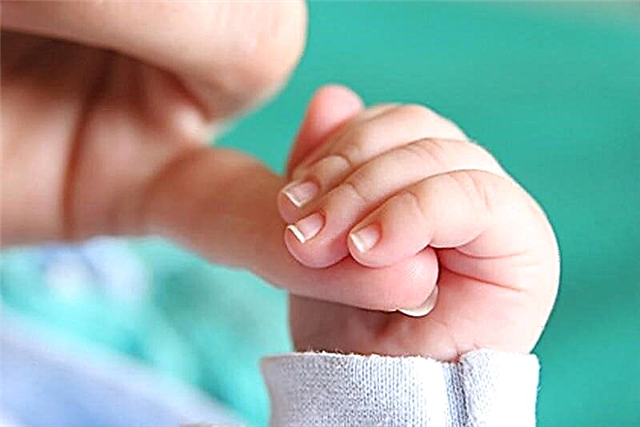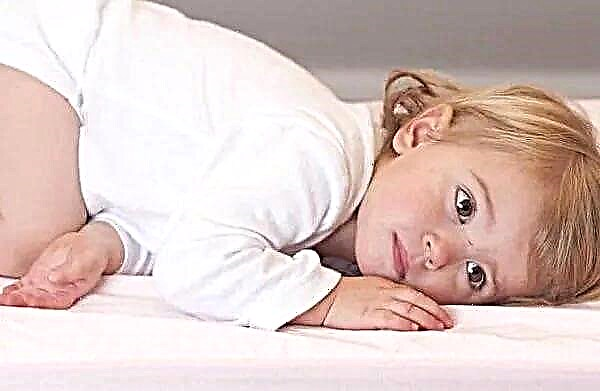Causes and mechanism of development of convulsive syndrome in children
Convulsive syndrome is an involuntary contraction of muscle fibers caused by excessive activity of neurons in the cerebral cortex and structures related to the motor zones. This paroxysm can be epileptic and non-epileptic.
The first one arises independently against the background of generation of an impulse by the cells of the pathological focus. And the second is a kind of reaction to stimuli (toxins, infection).
Background conditions for seizures
Childhood itself is a background condition for the development of seizures. Paroxysms in a child are observed 3-5 times more often than in an adult. The fact is that in the first year of life, the structures of the brain are only "ripening", the nerve fibers are not yet covered with a special myelin sheath, and the blood-brain barrier passes most of the internal and external toxins.
The brain tissue during this period is very hydrophilic, therefore there is a high risk of a rapid increase in the phenomena of edema and swelling.
An equally important contribution to the increased convulsive readiness of the child's body is made by the instability of metabolic processes in the nervous tissue, as well as the imbalance of inhibitory and excitatory mechanisms with a predominance of the latter. The situation is aggravated if the course of pregnancy was pathological, there was a threat of interruption, or the baby was born prematurely, with anomalies and malformations.
In adults, a predisposition to seizures occurs after traumatic brain injury, inflammatory diseases of the brain and its membranes (encephalitis and meningitis), hemorrhagic strokes. The brain of such a patient can be called provoked, since in the future it will react more sharply to infections, intoxication, hypothermia, stress, etc.

Causes of the convulsive syndrome
Factors or causes that can cause seizures include:
- epilepsy (idiopathic, symptomatic, or cryptogenic);
- breath holding - similar affective-respiratory seizures are observed in children under 4 years of age and represent a short-term sudden tonic muscle tension that occurs after a fright or a prolonged cry;
- fever. Febrile paroxysms are possible in children under three years of age, as a result of an insufficiently formed inhibitory system of the brain;
- tantrums... At the same time, convulsions have a bizarre appearance, are not accompanied by loss of consciousness and develop only in the presence of a “public”;
- fainting in some cases, accompanied by muscle contractions, if at this moment the person has not taken a horizontal position;
- metabolic disorders (hypo- or hyperglycemia, renal and hepatic failure) and intoxication (alcohol, mushrooms, pesticides, etc.);
- decreased calcium concentration in the blood causes a specific phenomenon - spasmophilia, which occurs due to hyperexcitability of peripheral nerve fibers. Involuntary flexion of the hands and feet are considered manifestations of pathology.
Key stages in the development of convulsive syndrome at the cellular level
The development of convulsive syndrome is based on a violation in the mediator system of the brain. An imbalance of inhibitory and excitatory substances is observed, which provokes depolarization of neuronal membranes, spreading from cell to cell. Thus, a hyperdischarge is formed, "walking" along the cerebral cortex and manifested by involuntary muscle contraction.
Classification of seizures
The nature and type of seizures is highly dependent on the factor that caused them. This pathological process can be considered both the direct cause of paroxysm, and be only a trigger. Attacks differ in time of onset, prevalence, form.
Partial
Partial seizures are a sign of symptomatic epilepsy and are:
- simple - with clear consciousness, muscle contraction occurs within one limb, face, etc.;
- complex - which are characterized by a premonition of an attack (unusual sensations in the abdomen, headache), impaired consciousness. During a seizure, the patient most often imitates some kind of movement;
- with secondary generalization. Beginning as simple or complex, the paroxysm ends in tonic-clonic seizures.
A similar convulsive syndrome is observed mainly in adult patients against the background of aneurysms, previous brain injuries, neuroinfections, and neoplasms.
Generalized
Generalized seizures are represented by absences, atonic, tonic-clonic and myoclonic equivalents. When people talk about convulsive syndrome, they usually mean the last two.
This type of seizure is typical not only for idiopathic and cryptogenic epilepsy, but is also a symptom of non-epileptogenic conditions: alcohol withdrawal (i.e. hangover), infectious diseases, metabolic disorders, etc.
Tonic-clonic
This paroxysm has two components tonic and clonic, which, by the way, can exist separately from each other. The first is characterized by muscle tension, flexion and subsequent extension of the limbs. The second manifests itself as uncontrolled frequent muscle contractions that set in motion not only the arms and legs.
This type of seizures always occurs against the background of a clouding of consciousness. May be accompanied by biting of the tongue and cheek mucosa. Its end is marked by involuntary urination. This allows you to distinguish a tonic-clonic seizure from a hysterical one.
Myoclonic
Despite the fact that myoclonic seizures occur against the background of clear consciousness, they are also generalized and are characterized by the presence of short-term muscle contractions, which can be arrhythmic, unilateral or bilateral. Most often seen in the limbs, tongue, or face.
How does convulsive syndrome manifest outwardly?

The signs of convulsive syndrome directly depend on what kind of paroxysm it is presented. There are also some differences between seizures in adults and children.
Features in children
Convulsive syndrome in children is usually represented by a tonic-clonic equivalent. During paroxysm, the child does not respond to external stimuli, the eyes roll back, the jaws are tightly clenched, the back arches and the head is thrown back. The arms are bent and pressed to the body, and the legs are extended.
Often, the tonic phase of an attack is accompanied by a slowdown in the pulse and respiratory arrest, but it lasts no longer than a minute. Then comes a series of clonic muscle contractions that look like twitching. They start from the face, gradually descending to the limbs. At this time, a bite of the tongue is possible, foam appears from the mouth, there is a risk of aspiration.
In young children, the characteristic lesions of the oral mucosa and post-attack urination are often absent.
In adults
Tonic-clonic paroxysm in adults practically does not differ from that in children. But often it develops again, due to the generalization of partial seizures. The latter can begin with twitching in one limb, and then move on to other parts of the body. This phenomenon is called jackson march.
Diagnostic procedures
The purpose of diagnosis for convulsive syndrome is to identify the factor that provoked the paroxysm. Since only then can the correct therapy be prescribed.
The survey in this case includes:
- patient interview or his immediate environment, specifying the nature of the attack, the time of its occurrence, the alleged reasons that caused it;
- physical examination, including not only the study of the neurological status, but also the assessment of the state of other body systems;
- laboratory tests (clinical analysis of blood, urine, biochemical blood test with the determination of the level of electrolytes and thyroid hormones) - allow you to identify metabolic and endocrine disorders, infectious processes, etc.;
- neurosonography (in children under one year old) or echoencephaloscopy, which, being ultrasound methods, show signs of increased intracranial pressure, masses;
- electroencephalogram - one of the main diagnostic methods, which consists in registering the biopotentials of the brain. Thanks to him, it is possible to differentiate the idiopathic or symptomatic nature of paroxysms;
- MRI or CT are used to visualize pathological changes in the central nervous system (hemorrhage, bruising, meningitis, encephalitis, aneurysm, etc.) that provoked convulsions.

Treatment of convulsive syndrome in children and adults
Treatment for seizures does not always involve taking anticonvulsants. This group of drugs is prescribed only after several paroxysms. They do not eliminate the cause of the pathology, but only prevent the development of the next attack.
Relief of an attack or emergency care
Emergency care for convulsive syndrome in children and adults has general principles and includes the following stages:
- the patient, if possible, is transferred to a flat soft surface or a pillow or rolled-up clothing is placed under his head;
- it is necessary to remove potentially dangerous items that can injure;
- shirt collar and belt are loosened, clothes are unbuttoned, allowing air access.
It is not recommended to forcefully open the patient's mouth and try to put a spoon or piece of wood in there, as this can lead to damage to the teeth and aspiration (getting into the respiratory tract) of their parts.
Further assistance falls on the shoulders of doctors.
Hospital treatment

If the convulsive syndrome lasts more than two minutes or muscle contractions follow each other and the patient does not come to his senses, then you should immediately seek medical help. Since this situation threatens the development of serious complications and can end fatally.
In a hospital setting, the main cause of the paroxysm is identified and the necessary treatment is prescribed.
Drug therapy
Drug therapy for convulsive syndrome is based on the elimination of the factor that provoked the attack. With febrile paroxysms, an antipyretic (Infulgan) or a lytic mixture (Analgin + Diphenhydramine) is administered. With spasmophilia - 10% solution of calcium gluconate. If the seizures are caused by poisoning and metabolic disorders, then detoxification therapy is carried out (Reopolyglyukin, Voluven, Gemodez, Reamberin).
In case of prolonged convulsions, tranquilizers are prescribed (Relanium, Diazepam, Sibazon).
Surgical intervention
Surgical intervention may be required if convulsive syndrome occurs against the background of an aneurysm, tumor, or brain abscess. Also, the operation is sometimes needed for bruises or hemorrhages in the substance of the cerebral hemispheres.
Temporal lobectomy or resection of the areas responsible for the generation of pathological impulses are the methods of treatment of resistant forms of idiopathic epilepsy.
Rehabilitation at home. Tips for parents
Parents of children who have already suffered convulsive paroxysm once need:
- prevent the development of injuries and infections in the child;
- if possible, eliminate stress factors;
- instill in children the concept of healthy eating and physical education;
- limit the time of using various gadgets, computers;
- monitor the work and rest regime.
If a child develops seizures, you should immediately seek medical help, rather than try to diagnose and treat the disease yourself.
Possible complications
Complications of convulsive syndrome are:
- edema and swelling of the brain substance with dislocation of stem structures;
- injuries during a fall;
- cessation of breathing;
- heart rhythm disturbances.
Prevention
Prevention of the development of convulsive syndrome in children consists in regular visits to the doctor during pregnancy for the timely identification and elimination of deviations in the health of the mother and fetus. After the baby is born, it is necessary to visit the pediatrician at the appointed time for preventive examinations.
In the event of paroxysms, it is necessary to fight the disease that caused them. It is possible to prevent febrile seizures by preventing the development of fever against the background of infectious pathologies in children. They disappear with age and only in 2% of cases transform into epilepsy.
Conclusion
The seizures suffered once do not always signal the presence of epilepsy. Paroxysms occur with a variety of pathologies, and often not of a neurological nature. Most of the conditions that accompany uncontrolled muscle contraction are successfully diagnosed and treated, allowing patients to forget about these unpleasant episodes and lead a normal life.



